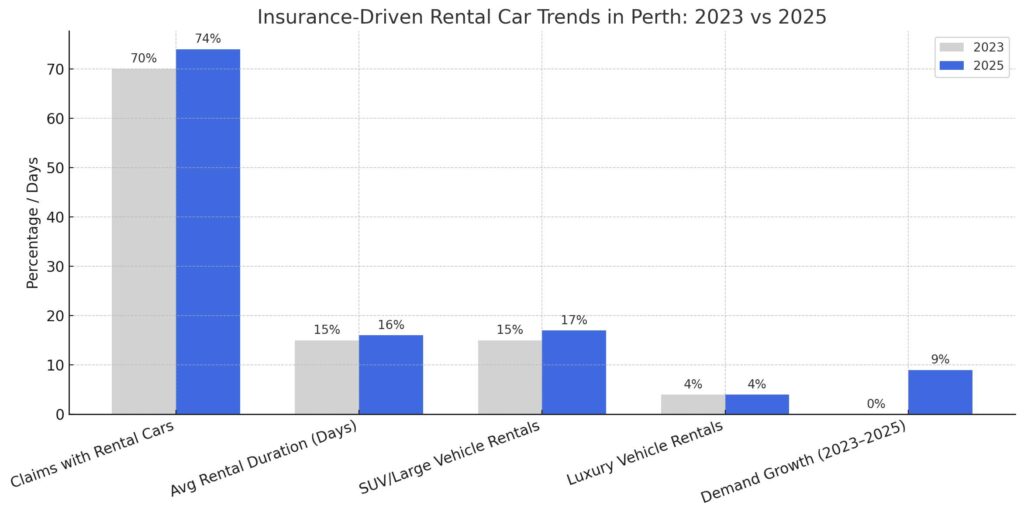In Perth, the consequences of a car accident in 2025 continue to extend well beyond the initial incident. Drivers frequently face the inconvenience of being without their vehicle during repair periods, impacting work, family responsibilities, and mobility. To address this, many insurers include the Right to Drive Perth provision in their comprehensive policies. This entitlement ensures policyholders are provided with a rental car during repair timeframes, helping them maintain routine activities without disruption. This article examines how accident-related insurance claims increasingly intersect with rental car usage under this provision, supported by 2025 insights into local rental trends.
Understanding the ‘Right to Drive’ Provision
The Right to Drive benefit remains a core inclusion in many comprehensive car insurance policies. By covering the cost of a temporary replacement vehicle, insurers reduce the stress associated with losing access to personal transport. This benefit is essential for those who rely on their vehicles for commuting, school runs, or caregiving duties. The rental car provided is typically a comparable model to the insured vehicle, and coverage generally extends across the full repair duration.

2025 Trends in Insurance Claims and Rental Car Usage
As of early 2025, usage of the Right to Drive benefit has continued to increase. Approximately 74% of insurance claims related to car accidents in Perth now involve the use of a rental car provided under this scheme. This marks a steady rise from 70% in 2023, and a notable jump from 50% recorded five years earlier.
The following factors are contributing to this trend:
- Improved Policy Transparency: Insurers are more proactively informing customers about their entitlements, resulting in greater uptake of the benefit.
- More Complex Vehicle Repairs: Modern vehicles, particularly EVs and hybrid models, require more time to repair, increasing reliance on rental alternatives.
- Industry Standardisation: As competitive pressure increases, the Right to Drive provision is now considered standard across many premium policies.
Breakdown of Current Car Rental Patterns
Rental car usage under the Right to Drive scheme in 2025 reflects evolving customer preferences and vehicle technologies:
- Rental Duration: The average rental period remains between 12 and 18 days, but some cases involving EVs and parts shortages extend beyond 30 days.
- Vehicle Types Chosen: Around 73% of policyholders still choose small or mid-sized vehicles for their fuel efficiency and practicality. SUVs account for 17%, while luxury or high-spec vehicles remain below 5%, typically due to policy constraints or cost limitations.
- Financial Implications: Rental cars in Perth now cost between $55 and $95 per day, with a two-week rental totalling approximately $770 to $1,330. The inclusion of this cost in insurance coverage continues to deliver significant financial value to policyholders.
Impact on Perth’s Car Rental Industry
The increasing reliance on rental cars post-accident has had a measurable impact on the local market:
- Sustained Demand: Rental providers in Perth have recorded consistent growth in demand linked to insurance claims, with a further 9% increase from 2023 to 2025.
- Fleet Adjustments: Providers have shifted focus to include more hybrid and fuel-efficient models, anticipating customer preferences and insurer alignment.
- Expanded Insurer Partnerships: Stronger partnerships between insurers and rental agencies have streamlined the process for claimants, with faster delivery times and direct billing arrangements now standard.

Advantages for Drivers in 2025
Utilising the Right to Drive provision continues to offer clear benefits:
- Routine Continuity: Drivers avoid relying on public transport or others for lifts, helping maintain professional and personal obligations.
- Cost Reduction: The full cost of the rental vehicle is typically absorbed by the insurer, avoiding out-of-pocket expenses during the repair period.
- Streamlined Processes: With most major insurers and rental companies now operating integrated claims and rental systems, access to replacement vehicles is quicker and requires minimal paperwork.
What’s Ahead for ‘Right to Drive’ in Perth
As the automotive landscape evolves, particularly with the growth of electric and smart vehicles, the Right to Drive provision is expected to adapt further. Future policy developments may include:
- Eco-Friendly Vehicle Options: Offering more hybrid or electric rental vehicles as standard options.
- Flexible Vehicle Categories: Giving policyholders a broader range of vehicle types depending on usage needs or preferences.
- Additional Benefits: Providing extras such as child seat compatibility, GPS navigation, or extended mileage allowances.
The Right to Drive Perth framework is increasingly seen as a baseline service expectation rather than a premium offering, reinforcing its place in comprehensive motor insurance products.
Conclusion
The ongoing integration of Right to Drive provisions with insurance claims management in Perth demonstrates a customer-first shift in vehicle accident response. Drivers are no longer left without options during repairs, and the system benefits both insurers and renters. For every car rental company in Perth, insurers partner with, aligning services to support this benefit is becoming essential. With continued growth in claim-related rentals and improved service models, the Perth market is likely to see even more customer-centric enhancements in the years ahead.
